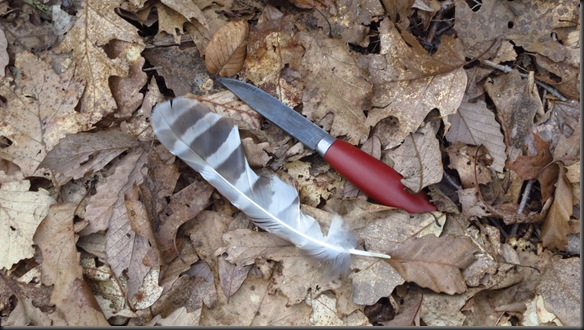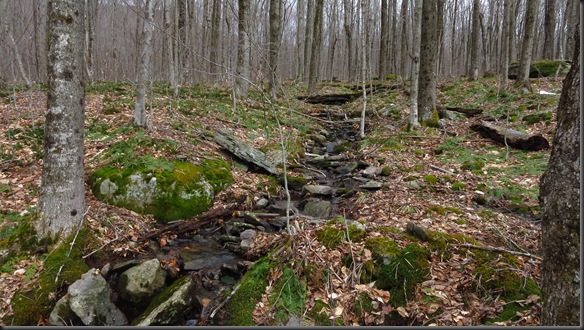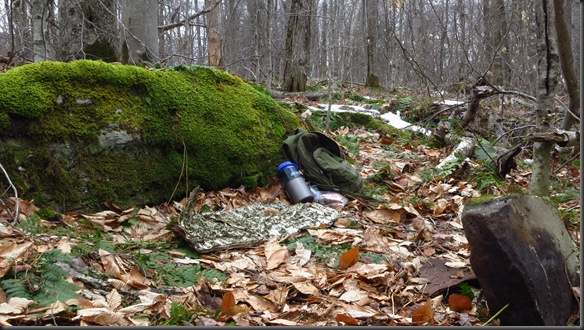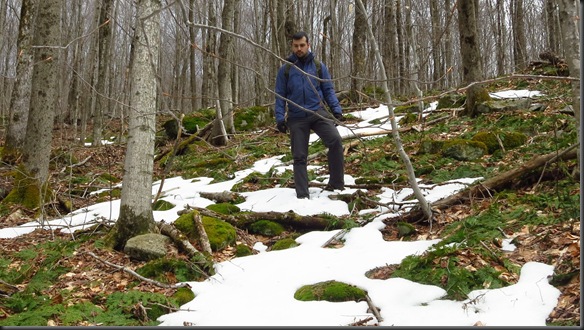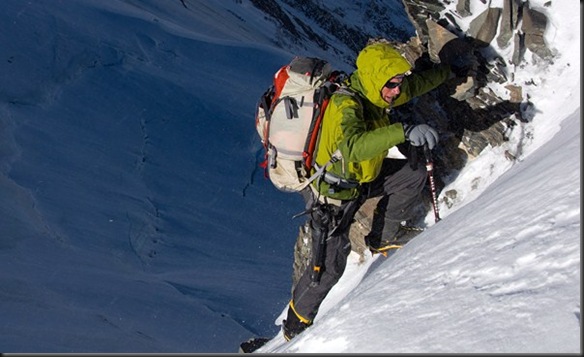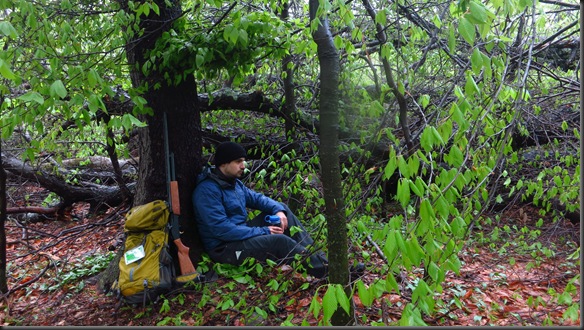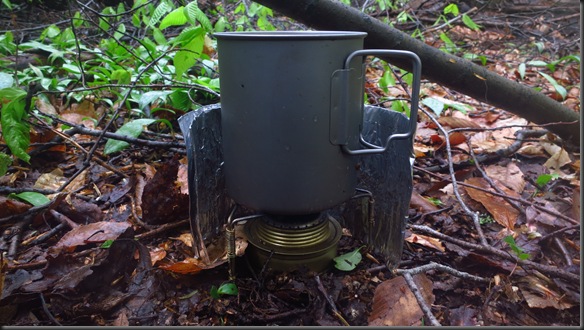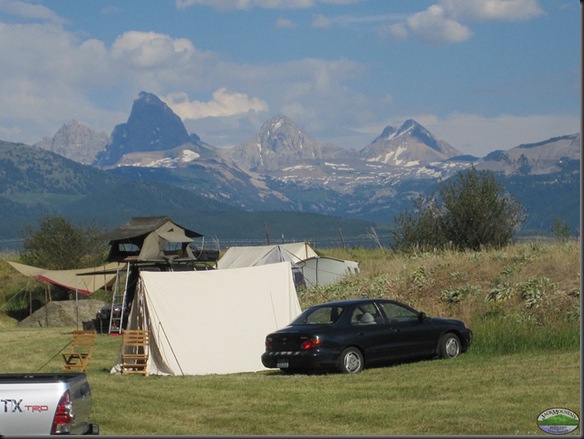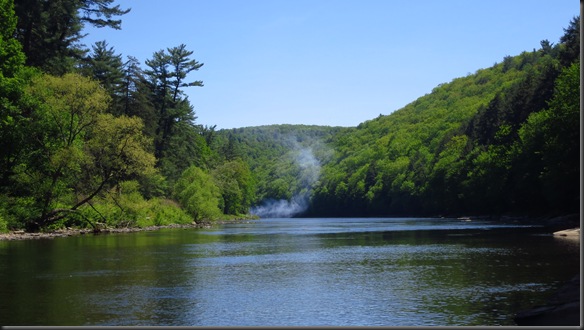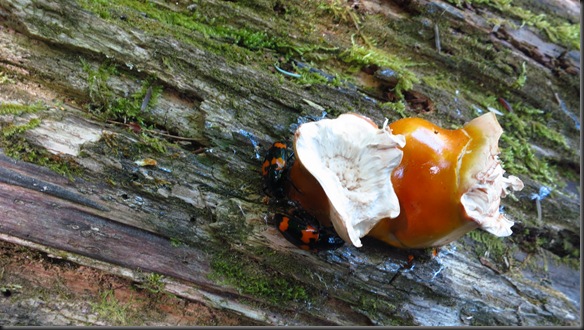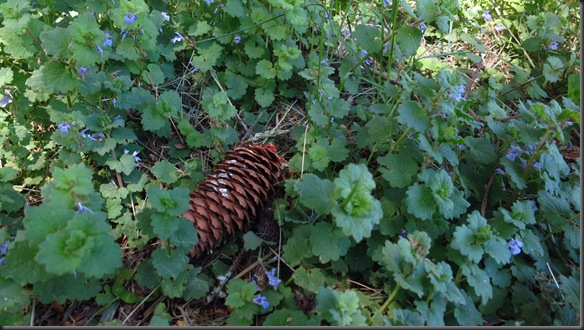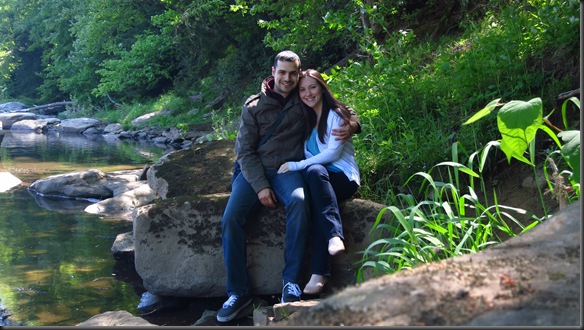In the state of New York, May is spring turkey season. As such, when I had some free time this past weekend, I gave it a go in the hopes of filling one of my tags. Here in New York, hunting of turkey during spring season is only allowed from half hour before sunrise till noon. You can only hunt toms (well actually only bearded birds-some hens have beards as well), and you can only collect two birds total, and it can not be on the same day. Anyway, enough for background.
Most turkey hunting is done is rural areas, near open fields, power lines, or roads, where the birds like to gather, and where food is plentiful. Unfortunately, those areas are usually on private land, or are completely overrun by people trying to get a shot at a turkey. As an alternative, I decided to go to a location in the mountains where last fall I had noticed some turkey sign (actually a friend of mine noticed it). Hunting for turkey in the mountain is more difficult because they are more spread out, there aren’t any open areas where you can get long range shots, and you can not carry equipment like decoys up there with you. In my opinion however it makes for a more interesting experience. The mountain I chose is the Van Wyck Mountain which is located in the Sundown Wild Forest in the Catskills. You may remember the area from a trip report where the guys from Blades and Bushcraft and I searched for the crashed airplanes. You can have a look at it here. The plan was to go to the area on Saturday, bushwhack up the mountain for most of the day, so I can get to possible hunting locations deep enough in the forest so that the birds would not have been disturbed by people, spend the night there, and then set up for the hunt on Sunday morning.
So, on Saturday I got in the car and drove up to the forest. It was raining when I left. I had expected some rain, but by the time I got to the forest, and had taken a few pictures, the rain started seriously coming down. To make things worse, the trip started out with me having to cross a river, which had gotten quite large due to all the rain this past week.
![Copy of 013 Copy of 013]()
There was no clear way to cross. Even with rock hopping, I would still have to get submerged. I figured that it wouldn’t be a big deal because my GoreTex boots are waterproof, and quite high, so some water wouldn’t be an issue. Unfortunately, as I started trying to make my way across, I lost my footing and stumbled into the water. I got wet up to the knee, and my boots were filled with water. It would be wet boots for the rest of the trip.
On the other side the terrain immediately became very steep. For close to an hour, I had my face right over the ground. I wasn’t terribly happy with my shotgun sling. While it is comfortable to use on level ground, on the steep terrain it allowed the shotgun to swing too much.
Eventually I made it up the steep terrain and onto some more level ground. At the same time the rain started to ease up, and under the tree cover, you could hardly notice it. From the very beginning, I started seeing a lot of deer scat. In fact, it’s been a while since I’ve seen so much of it. If they ever open a spring deer season, I know where I will be.
![037 037]()
![131 131]()
Still no sign of turkey though. As the rain slowed down, I was able to take off my shell. They say GoreTex is breathable, and I’m sure it is on some level, but when it is this humid, it just can not move the moisture out quickly enough. That being said, there is no other material I would rather have in the rain.
![Copy of 118 Copy of 118]()
The terrain was starting to open up a bit, making it better suited for turkey. I continued to scan the ground. Hey Ross… why are you wearing hunters’ orange during turkey season? Because I want to make it very clear that I am not a turkey while traveling to the location. Between the orange hat and the yellow pack, I figured I had it covered.
For this trip I used my REI Flash 62 pack. I was carrying very little gear, which I will go over later, so the pack was mostly empty. I brought it because it serves as a good frame for carrying out any kill. The floating pocket in the front allows for secure attachment of bags to the frame of the pack, even though I’m sure it was never intended to fulfill that role.
After some scanning, I spotted some turkey scat. It was from a hen, and it wasn’t particularly fresh. I was starting to get worried that this area was just a feeding ground for turkey in the fall but that they had moved to a different location to mate.
![087 087]()
I kept climbing up the mountain for a few more hours. All of a sudden, to my four o’clock position, I heard the familiar helicopter sound of a turkey flying off. I turned, and what looked to be a hen took off from the bushes no more than ten yards away from me. It shot up like a pheasant. Unfortunately it was after hunting hours, and I couldn’t confirm the gender of the bird while it was in flight. After it took off, I searched the area, and found some scat.
![144 144]()
While the rain was making it hard to judge, this scat was a lot more recent, and there was a bunch of it in the area. My optimism started to grow. All around the area there were these green plants you see in the picture. I’m not sure what they are, but it crossed my mind that the birds might be feeding on it. It looked to have small tubers as roots. The one in the picture is the way I found it. It was not pulled up by me.
![151 151]()
I kept going. I was keeping my eyes open for a nice clear spot where I might be able to hunt the following day. As I was searching, I spotted something through the trees. It was one of the airplane crash sites. By complete accident, I had stumbled across it.
![159 159]()
If I had to navigate to the location, it would be a challenge, but I had stumbled upon it by dumb luck. I continued up the mountain, and eventually reached a semi-clear area where I noticed a good amount of turkey scat. I know, I know, it’s a very poop centered post. It was still hen scat, but I figured it was worth a try.
![165 165]()
By this point the rain was coming down again pretty hard. I decided to stop and look for a place where I could spend the night.
For this trip I had come with very little gear. I had no tent or sleeping bag. In fact, all I had was my day kit, a water bladder, my Trangia stove, a box call, my shotgun and some ammo. Sorry for the poor quality of the picture; the camera had gotten wet.
![219 219]()
In part my gear choice was made in order to create a challenge, and in part so I didn’t want to carry too much weight up the mountain. Other than what you see in the picture, I had my regular three season clothing. You can see more details about it here. My shotgun is a Mossberg 500 20 gauge. for this hunt I was using a Mossberg turkey choke and Remington 3 inch, number 6 shot, 1 /1/4 load shells. The box call is just a regular one I grabbed off the shelf. I still can’t use a mouth call, which would be a much lighter and more compact option. I’ll keep practicing. I had a small DIY pot support for the Trangia, and I didn’t bring any extra alcohol other than what was stored in the Trangia. The black bag you see in the picture is just my food (and spoon).
Since I stated that my focus in posts related to hunting will be backpack hunting, I feel I should mention that the shotgun I am using is not ideal for this type of hunting. The Mossberg 500 is cheap, and it is reliable. It’s a good gun. For turkey hunting, at least in New York State, you have to use a shotgun, and it has to be either 20 or 12 gauge, using shells with shot size of between number 8 and 2.
Wow, what does that mean? If you are not familiar with shotguns, the gauge is the size of the diameter of the barrel. The larger the number, the smaller the diameter. So, a 12 gauge shotgun has a wider barrel than a 20 gauge one. Gauge is determined from the weight of a solid sphere of lead that will fit the bore of the shotgun, expressed as fractions of a pound. So, 1/20 pound ball fits in a 20 gauge shotgun barrel.
On the other hand, the size of the load represents the size of the pellets that are shot out of the shell. Unlike a rifle, a shotgun shell typically shoots out numerous small balls that spread out in a cloud, instead of a bullet. The larger the number, the smaller the balls, but the more of them there are.
All that being said, the Mossberg 500 20 gauge shotgun weighs 6 lb 11 oz. That is a heavy gun. It weigh as much as my tent, sleeping pad, and sleeping bag combined. It is not fun to carry. Unfortunately, there aren’t much better alternatives. It may seem like getting a single shot shotgun, something like the H&R Topper would be a much lighter option, but surprisingly, it is not. If we are looking for serious hunting shotguns, we have to start with a gun that among other things has adjustable chokes. A choke is the tightening of the barrel at the very end. The tighter the choke, the more it squeezes the shot pellets, allowing them to keep a tight pattern over longer distances. On most hunting shotguns, you can change the chokes by screwing in new ones. Well, the lightest H&R with adjustable chokes is the H&R Topper Deluxe, which weighs 6 lb, with the synthetic stock. Not much lighter. There is a lighter 20 gauge shotgun by Benelli. It’s called the Benelli Ultralight, and comes in at 5 lb. Unfortunately, it also comes with a $1700 price tag. I have not been able to find a good solution to the problem.
Anyway, the rain was coming down, and I was looking for a place to camp out for the night. I found a group of trees that blocked the rain quite effectively. I got to work, adding additional branches as cover, and some more on the ground. The result was a tiny shelter that would keep the worse of the rain off.
![242 242]()
There would be no fire on this trip. I wasn’t planning on it from the beginning. My decision was made even more sure by the wet conditions. Making a fire in such wet weather will fill the forest with smoke, assuring that every animal in the vicinity will run away. Not exactly the best idea when hunting.
To cook I had brought my Trangia Mini. I chose it over my other alcohol stoves because I didn’t have to bring a separate fuel bottle, as the Trangia stores the fuel inside. I also brought a light DIY pot stand and an aluminum foil windscreen. The plan was to boil some water for a Mountain House dehydrated meal. That’s exactly what I did.
![262 262]()
The night was cold. In fact too cold. I got very little sleep, and twice I had to light up the stove to make some warm tea. I was surprised that the stove had enough fuel to get the job done, but it did. Being wet is just no fun. It makes things much worse. Even though I had managed to keep my insulation relatively dry, a lot of my clothing was wet, and so was everything around me. Let me be clear, there is no clothing that will keep you warm when you are wet. The parts of me covered in wool were just as cold as the parts of me covered in fleece. Wet is wet, and wet is cold. I spent the night shivering.
In the morning, I picked out a spot, sat near a tree and started calling. I heard another hen clucking, but no toms. I sat and I sat, and then I sat some more; the entire time trying not to move. I didn’t have any decoys, nor did I have special clothing. The only thing I brought was my gloves to cover my hands and a face mask. Coincidentally, I used the face mask during the evening to keep the massive amount of flies that were in the area off my face, and then during the night for extra insulation. After many slow hours, noon rolled around. Before I packed up, I took aim and…
![276 276]()
… boom…
![283 283]()
That’s one dead turkey. At this rate I’ll have my tags filled in no time. Even though it wasn’t a successful hunt, I was happy with the trip at this point. I had managed to locate several areas where there were turkeys, I saw one in the woods, and heard several others. While the night was miserable and I didn’t get much sleep, I had made it through. Now it was time to head back home. This is when the trip turned into a humiliating fiasco. But, before that, here is a picture of some strawberry plants:
![002 002]()
The weather had improved. It was still cloudy and there were some rain drops, but overall, the rain had stopped. Assured that I will be out of the forest in a few hours, I confidently set out down the slope. I knew that the airplane site I had encountered was a bit east from where I started, so I decided to keep slightly west in order to return to the same location. It turns out “slightly” is not a good measurement when it comes to navigation.
This part of the mountain is surrounded by rivers on three sides. On the bottom, running from east to west is the river I crossed at the beginning of the trip. On either side of the mountain are rives that run north to south all the way down to the third river. Well, after a few hours of walking down the slope, I started to hear a river on my left. That shouldn’t have happened. The only thing I could think of was that I had drifted too far east, and was getting close to the river running from north to south. I shifted my direction west, but again, started to hear water. Could it be that I was already back down to the river I crossed initially? I tried to find an area where I could actually reach the water to have a look, but the slopes dropped off abruptly. They were to steep for me to go down, especially since I wasn’t sure of my location. I tried walking in what I though was an east and west direction along the river to find a crossing point. No luck. It just made no sense, and now it was starting to get late in the day.
With me, I had a small button compass that I keep on my pocket kit. I know it sounds ridiculous when you hear stories about people not trusting their compass, but that’s exactly what I had been doing for the last few hours. I was trying to go south, but my compass kept telling me that south was to the east (according to me) and up the mountain. It made no sense, so I decided it was a cheap little compass and there was something wrong with it. At this point however, after hours of fumbling around, I decided that I must indeed be very wrong about what I thought was my location. I stopped, pulled out the map and compass, and started from scratch. After quite some time of thinking this through I figured it out. Here is the GPS recoding on my tracks that I downloaded when I got back home:
![1 1]()
It confirmed that my new plan had been right. Let me try to make some sense of it for you guys. Below you can see a reconstructed map of the trip.
![Copy of 1 Copy of 1]()
The blue line is the route I took up the mountain and to the location where I finally hunted. It is also the way I though I was heading down the mountain. My real route down the mountain is shown in red. Due to carelessness, I failed to maintain my direction, and simply headed down the slope. Unfortunately, I headed down the wrong slope. As you can see, the slope from the southern side of the mountain converges with the slope form the west side of the mountain near the location where I had spend the night. A small deviation at that point set me down the wrong side of the mountain. Since I was not paying attention to my bearing, I didn’t think much of it. The green line is the route I took once I figured out what had happened. As you can see, I overshot my route up the mountain because I wanted to make sure I was on the southern slope. It unfortunately lead to a much tougher river crossing.
By the time I started on the proper route, the sun was going down. Soon it was completely dark. It’s a good thing I had a small flashlight in my pocket kit. Otherwise I would have had to spend another night in the woods. Navigation in the dark was very difficult, especially because of the steep terrain, but I managed it.
Eventually I reached the river, the one for which I was aiming. Unfortunately I had stumbled onto a portion that had a rock outcrop on one side and a swampy area on the other. I was way too tired to try circling around to look for better spots. I decided to cross right where I was. This is the best I could do in terms of taking a picture of the river with the flash on my camera.
![289 289]()
I stepped into the water and moved forward. Suddenly, one of my legs plunged into much deeper water than I expected. I fell down to my waist. I lost my balance and got swept by the river. Fortunately, the deep portion soon ran out, and I hit some rocks. I was then able to stand up and cross the rest of the river without much of a problem. I’m not sure if all the rain the previous day had risen the level of the river, or if I had just selected a particularly deep spot to cross. Either way, the one right thing I did was to put everything from my pockets into my pack. Even though it is not technically waterproof, it kept everything dry when I fell in the water. That’s the reason you are now able to see the pictures.
I knew I was almost out, and I pushed through the brush. Something flashed in the distance and caught my eye. It was a sign by the side of the road.
![291 291]()
Few more steps and I was out. Just by dumb luck, I could see the car from where I was standing. I was finally out…then I got lost driving on the way home.
Here is the elevation profile of the trip. The first bump is the one where I went up the mountain. Everything else is my misguided efforts to get out.
![2 2]()
As you can see, I went up the mountain, then down the western slope to the river, then back up the western slope, and eventually down the southern slope.
So, lesson from all this… do as I say, not as I do. Don’t get complacent. It is the easy parts of a trip that will create problems for you because that is when you are paying the least attention.
Overall, not bad. I did hurt my right knee pretty bad, but I didn’t notice it until I was out of the woods. I’ve been hopping around for the last few days.







